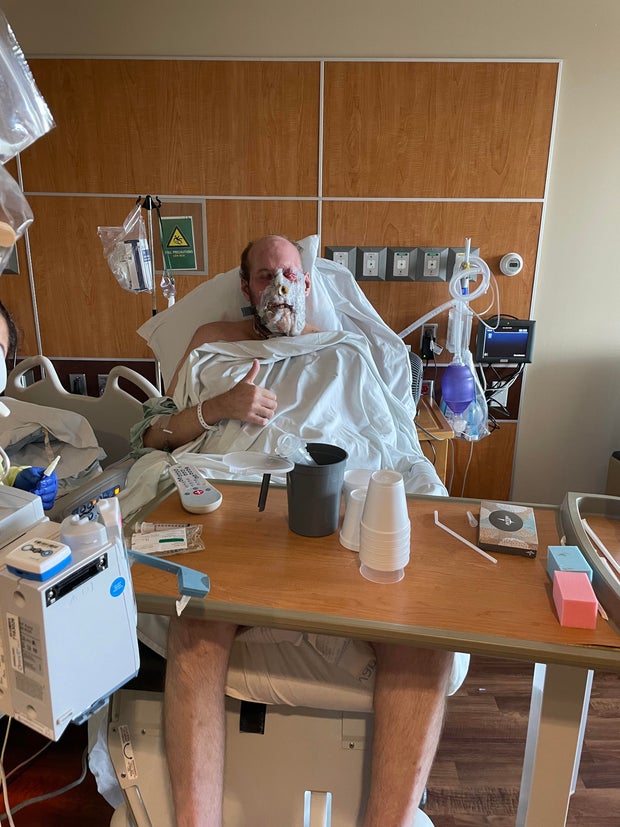Share this @internewscast.com
An Arkansas man has a new eye after being the subject of the first-ever human eye transplant in May.
The eye transplant was part of a complex partial-face transplant performed by a team of surgeons at NYU Langone Health in New York City. Aaron James, a high-voltage utility line worker, lost most of his face in a work accident in June 2021, when it accidentally touched a 7,200 volt live wire while out on a job.
Dr. Eddie Rodriguez, one of James’ doctors for the transplant, said it’s not an injury many would have survived.
“He was alive. They bring him down. They rush him to the regional burn unit,” Rodriguez said. “And he’s in bad shape. They have to amputate his arm (above the elbow), so right at the midarm. His face is destroyed … Forget about replacing the arms, the face. We gotta keep this guy alive.”
The James family
James, 46 said he doesn’t “remember any of it,” but when he woke up, he had lost his nose, his front teeth, his left eye and his dominant left hand. He also lost his chin down to the bone, 20% of his tongue, his left cheek, and his lips. After multiple reconstructive surgeries, he couldn’t eat or drink normally, and had trouble speaking, so he agreed to undergo the face transplant, including the world’s first transplant of a donor eye. The transplant came from a single donor, making it “the only successful combined transplant case of its kind,” according to NYU Langone Health. The donor was a man in his 30s who donated tissue to three other people, as well as James.
“A whole eye transplant’s never been done,” explained Rodriguez, who performed the world’s first successful face and double hand transplant in 2020. His colleagues were skeptical of the idea of a face and eye transplant, but James was immediately on board.
“He didn’t hesitate,” Rodriguez recalled. “He said, ‘If I can help out other people and then I can help out other soldiers, it’s worth it. He had three tours … He knows the value of helping out his fellow soldier.”
James served in the Army National Guard and completed tours in Egypt, Kuwait and Iraq, according to NYU Langone Health.
Dr. Vaidehi Dedania became involved in the surgery as James’ eye specialist. Dedania, an associate professor of ophthalmology and the director of the Vitreoretinal Surgery Fellowship at NYU, is a retina expert who worked to see if the new eye could actually send the right signals to the brain to process an image, restoring James’ sight.
In late May, Rodriguez and the surgical team spent 21 hours in surgery, transferring the donor’s face, eye socket and eye to James. A huge challenge was providing blood flow to the transplanted eye.
Joe Carotta / NYU Langone
“It was an exhilarating moment to just see that blood supply coming to the retina,” Rodriguez said.
The team also had to worry about nerve regeneration and immune rejection. These concerns are part of what have made whole-eye transplants so elusive, NYU Langone said. The research team combined the donor eye with donor bone marrow-derived stem cells in an attempt to enhance the nerve regeneration — something that had never been tried before. Those bone marrow cells were injected into James’ optic nerve during the surgery.
Read Related Also: EXCLUSIVE: EastEnders actress Letitia Dean hits out at online scammers for falsely using her slimmed downed image to promote weight loss pills
After a few weeks in the hospital and some rehabilitation, James was considered recovered from the transplant. He said he still has some trouble speaking, but that has gotten better, and he’s working to regain feeling in his lips and get his jaw to open more than it currently can. According to NYU Langone, he can now do things that were previously impossible, like eat solid foods. The transplant has also boosted his confidence.
“It just blows my mind,” James said. “I tell everybody, if I get close to a mirror, I just stare at it. … Now I want to go outside and let people see me, you know?”
However, a question still remained: Would light shone into the transplanted eye be recognized by the part of the brain that processes vision?
To find out, James underwent two functional MRIs, which measure small changes in blood flow that happen with brain activity. Dedania said the team first confirmed that James had blood supply, pressure in the eyeball, and a healthy retina, then put bright light into his eye and measured the retina’s electrical response.
Russ Geltman / NYU Langone
“What that showed us was that the photoreceptor cells … were actually sending a signal back,” Dedania said. “That’s the moment where we were saying, ‘Wow, so there’s blood supply. The cells are still preserved, and he’s able to, at least the retina is able to respond to a stimulus such as light.”
Dedania and Rodriguez tested it with another functional MRI, where they worked with a research team and neuroradiologist. First, the team covered James’ transplanted eye and flashed a light. That image was normally recorded in the visual cortex, Rodriguez said.
Next, the team covered James’ functional eye and tested the transplanted one.
“We saw a response back there!” Dedania said. “Can we be more astonished? Every level, every test has further increased our understanding of how this eye is functioning within his body.”
While James was able to process the light, the sight in that eye has still not been restored. Dedania was skeptical that it would return fully, but said she would “never say never.” James will continue to be tested to see if his sight can be restored.
“This is unprecedented. The question is, is it possible? Yes,” Dedania said.
“We don’t have sight yet, but I’m an optimist,” Rodriguez said. “The one thing for sure that I can say now is that we are one step closer.”
















